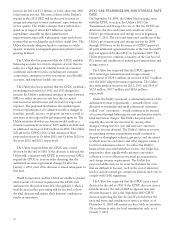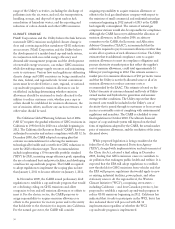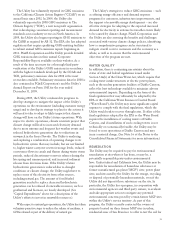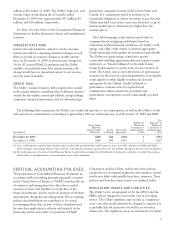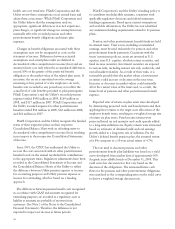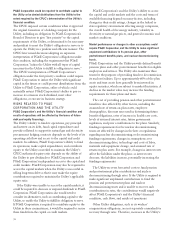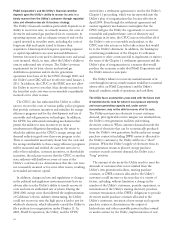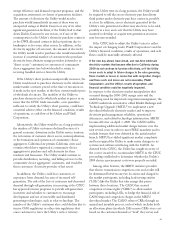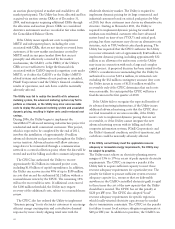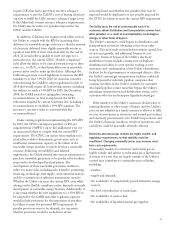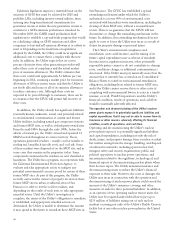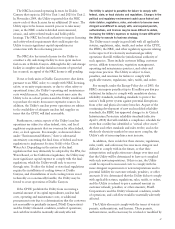PG&E 2009 Annual Report Download - page 41
Download and view the complete annual report
Please find page 41 of the 2009 PG&E annual report below. You can navigate through the pages in the report by either clicking on the pages listed below, or by using the keyword search tool below to find specific information within the annual report.
The following reflects the sensitivity of pension costs
and projected benefit obligation to changes in certain
actuarial assumptions:
(in millions)
Increase
(Decrease) in
Assumption
Increase
in 2009
Pension
Costs
Increase in
Projected
Benefit
Obligation at
December 31,
2009
Discount rate (0.5)% $70 $746
Rate of return on
plan assets (0.5)% 40 –
Rate of increase in
compensation 0.5% 32 176
The following reflects the sensitivity of other
postretirement benefit costs and accumulated benefit
obligation to changes in certain actuarial assumptions:
(in millions)
Increase
(Decrease) in
Assumption
Increase
in 2009
Other
Postretirement
Benefit Costs
Increase in
Accumulated
Benefit
Obligation at
December 31,
2009
Health care cost
trend rate 0.5% $6 $39
Discount rate (0.5)% 6 84
Rate of return on
plan assets (0.5)% 5 –
ACCOUNTING PRONOUNCEMENTS
ISSUED BUT NOT YET ADOPTED
TRANSFERS AND SERVICING (TOPIC 860) —
ACCOUNTING FOR TRANSFERS OF FINANCIAL
ASSETS
In December 2009, the Financial Accounting Standards
Board (“FASB”) issued Accounting Standards Update
(“ASU”) No. 2009-16, “Transfers and Servicing (Topic 860)
— Accounting for Transfers of Financial Assets” (“ASU
No. 2009-16”). ASU No. 2009-16 eliminates the concept of
a qualifying special-purpose entity and clarifies the
requirements for derecognizing a financial asset and for
applying sale accounting to a transfer of a financial asset. In
addition, ASU No. 2009-16 requires an entity to disclose
more information about transfers of financial assets; the
entity’s continuing involvement, if any, with transferred
financial assets; and the entity’s continuing risks, if any,
from transferred financial assets. ASU No. 2009-16 is
effective prospectively for PG&E Corporation and the
Utility beginning on January 1, 2010. PG&E Corporation
and the Utility are currently evaluating the impact of ASU
No. 2009-16.
CONSOLIDATIONS (TOPIC 810) —
IMPROVEMENTS TO FINANCIAL REPORTING BY
ENTERPRISES INVOLVED WITH VARIABLE
INTEREST ENTITIES
In December 2009, the FASB issued ASU No. 2009-17,
“Consolidations (Topic 810) — Improvements to Financial
Reporting by Enterprises Involved with Variable Interest
Entities” (“ASU No. 2009-17”). ASU No. 2009-17 amends
the Consolidation Topic of the FASB Accounting
Standards Codification (“ASC”) regarding when and how
to determine, or re-determine, whether an entity is a
variable interest entity (“VIE”). In addition, ASU
No. 2009-17 replaces the Consolidation Topic of the FASB
ASC’s quantitative approach for determining who has a
controlling financial interest in a VIE with a qualitative
approach. Furthermore, ASU No. 2009-17 requires ongoing
assessments of whether an entity is the primary beneficiary
of a VIE. ASU No. 2009-17 is effective prospectively for
PG&E Corporation and the Utility beginning on January 1,
2010. PG&E Corporation and the Utility are currently
evaluating the impact of ASU No. 2009-17.
RISK FACTORS
RISKS RELATED TO PG&E CORPORATION
As a holding company, PG&E Corporation depends on
cash distributions and reimbursements from the Utility
to meet its debt service and other financial obligations
and to pay dividends on its common stock.
PG&E Corporation is a holding company with no revenue
generating operations of its own. PG&E Corporation’s
ability to pay interest on its $247 million of Convertible
Subordinated Notes and to pay dividends on its common
stock, as well as satisfy its other financial obligations,
primarily depends on the earnings and cash flows of the
Utility and the ability of the Utility to distribute cash to
PG&E Corporation (in the form of dividends and share
repurchases) and reimburse PG&E Corporation for the
Utility’s share of applicable expenses. Before it can
distribute cash to PG&E Corporation, the Utility must use
its resources to satisfy its own obligations, including its
obligation to serve customers, to pay principal and interest
on outstanding debt, to pay preferred stock dividends, and
meet its obligations to employees and creditors. If the
Utility is not able to make distributions to PG&E
Corporation or to reimburse PG&E Corporation, PG&E
Corporation’s ability to meet its own obligations could be
impaired and its ability to pay dividends could be
restricted.
37



